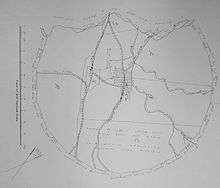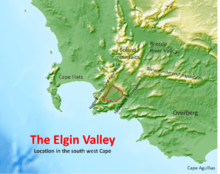Elgin, Western Cape


Elgin is a large, lush area of land, circled by mountains, in the Overberg region of South Africa. This broad upland valley lies about 70 km southeast of Cape Town, just beyond the Hottentots Holland Mountains. The Elgin region is centered on the town of Grabouw.
The Elgin Valley is now internationally known as the place in South Africa “where the apples come from”.[1] The area is one of the more intensively farmed districts of South Africa and produces 60% of the national apple crop.
Grabouw

Today, the town of Grabouw, in the heart of the vast Elgin Valley, is the commercial centre for what is the largest single export fruit producing area in Southern Africa.
Grabouw was created on the farm Grietjiesgat acquired on 22 November 1856 by Wilhelm Langschmidt, who named the place after Grabow, the village of his birth in Germany. His wife opened a small trading store and he was the bookkeeper. Later he sold parts of his farm and so began the farming community of Grabouw as it was later spelled. Langschmidt was the father of 23 children, including 3 sets of twins.
History and development of the Elgin valley



The original inhabitants of the area were the Khoikhoi pastoralists and the San hunter gatherers. The Dutch colonists began to move into the area in the late 1600s.
Over a hundred years later, in the early 1800s, the valley had acquired the nickname "Groenland" ("Greenland"), and was a relatively underdeveloped backwater. The area around where the current Elgin station stands was originally named Koffiekraal. It served mainly as a place to unhitch oxen from the wagons between Bot River and Palmiet River on the Cape Town to Caledon road.
The development of the region changed substantially in the early 20th century, with the arrival of the two most influential pioneer families of the area, the Viljoens and the Moltenos.
Sir Antonie Viljoen, an Afrikaans medical doctor, bought a farm named Oak Valley Estate in the Elgin Valley in 1898. He spent much of the next few years under house arrest on his farm (he had signed up as a medical officer with the Boer army, during the war, and was soon captured by the British. Interestingly, his internment on Oak Valley was only granted on condition that he paid for the services of two British soldiers to guard him for the duration of the war!) Antonie Viljoen was a farmer extraordinaire growing everything from grape vines to potatoes. Amongst his many farming achievements were the purchase of the first deciduous fruit trees in the Elgin valley. These were initially grown and maintained by his farm labourers, largely as their own separate concern, however they constituted the first known deciduous orchard in the region.[2]
In 1903 an Italian South African family named Molteno began farming in the area. Two friends of Dr Viljoen, the young brothers Edward and Harry Molteno initially bought a small plot of land named "Glen Elgin", where they grew vegetables. They soon started growing deciduous fruit though, and quickly built up a vast fruit farming enterprise that spanned the entire valley. Charismatic and eccentric, they long dominated the fruit export industry but later left their enormous network of farms, as a trust, for the use, distribution and ongoing benefit of the farm workers and the region's inhabitants. The name of their original farm subsequently came to refer to the valley, and when the brothers donated land for the valley's railway station, that station was also named Elgin by the railway company.[3]
These early farming groups had a strongly liberal effect on Cape politics. Sir Antonie was an MP in the Cape Parliament and, together with fellow MP James Molteno, he launched the first movement to give women of all races the right to vote, in 1907. Another progressive local entrepreneur who had an enormous influence on the valley was Kathleen Murray, who was a leader in the Black Sash among other political activities.[4][5]
In 1966, on Applethwaite farm, Edmond Lombardi created and introduced to the market a 100% apple-juice beverage, free of additives and preservatives, known as Appletiser. Appletiser[6] is now owned by SAB Miller and is sold across Europe, Asia, and North America.
Deciduous fruit, Flowers and Wine

Today the Elgin valley is renowned for its apples and pears, its greenhouse cut flowers, its rose growing, and, increasingly, for the production of high quality cool climate wines.
Over 40 percent of South Africa’s apple production is exported,[7] and the Elgin Valley produces about 60 percent of the total annual apple crop of about 819,000 metric tonnes (2012 data).[8] Industry and government export estimates can vary slightly. The United Kingdom is the top destination for South African apples, with Malaysia, Benin and Netherlands as the next largest importers of South African apples. Granny Smith and Golden Delicious were the top apple varieties exported in 2007/08. South Africa is said to be the only southern hemisphere county that produces a top quality Golden Delicious apple, a major advantage against competing exporting countries.
See also
| Wikimedia Commons has media related to Elgin, Western Cape. |
References
- ↑ Elgin Valley Information Center http://www.elginvalley.co.za/default.aspx, 3 August 2009
- ↑ S. Stander: Tree of Life. The Story of Cape Fruit. S&W Ltd. Cape Town. 1983. p.62.
- ↑ Phillida Brooke Simons: Apples of the sun : being an account of the lives, vision and achievements of the Molteno brothers. Vlaeberg: Fernwood Press, 1999. ISBN 1-874950-45-8
- ↑ M.Coburn: The Overberg: Inland from the Tip of Africa. Struik, 2005. p.18.
- ↑ Molteno, J.T.: Further South African Recollections. London: Methuen & Co. Ltd, 1926. p.130.
- ↑ Appletiser USA website http://www.appletiser.net/aw/applications/aw/usa/home.html, 8 December 2009
- ↑ USDA Foreign Agricultural Service: GAIN Report Number: SF8016, pub. 19 June 2008
- ↑ Binard, M. Phillipe. "WAPA Releases Southern Hemisphere Apple and Pear Crop Forecasts" (PDF). WAPA Press Release. Retrieved 24 May 2013.
34°08′55″S 19°02′34″E / 34.14861°S 19.04278°E